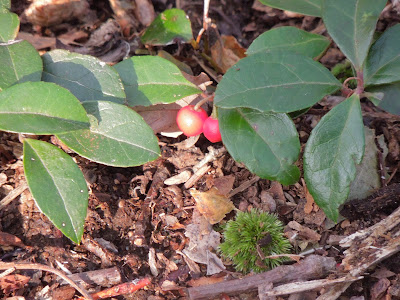Folks of a certain age will probably remember the
Teaberry Shuffle, a simple dance featured in a series of commercials of the 1960's promoting Clarke's Teaberry chewing gum. But did you know that the source of that familiar, Wintergreen flavor, is the native groundcover,
Gaultheria procumbens, or Eastern Teaberry, and is a welcome addition to any shade, or rock garden to add winter interest.
The genus was named for Dr. Gaultier, a Canadian naturalist and physician of the middle 1700's. Procumbrens comes from from the Latin verb
procumbere to fall forwards, referring to its prostrate, or creeping along the ground form. According to a
Rutgers University fact sheet, the Massachusetts explorer,
Jonathan Carver wrote about it in his
Travels Through the Interior Parts of North America in the Years 1766, 1767, and 1768, first published in 1778, describing it “in winter it is full of red berries about the size of a sloe [small fruit of the blackthorn], which are smooth and round; these are preserved during the severe season by the snow, and are at that time in the highest perfection. The Indians eat these berries, esteeming them very balsamic and invigorating to the stomach”.
Eastern Teaberry is a spreading, evergreen, shrub which only grows 4 to 8 inches tall. It spreads primarily through undergound stems (rhizomes), sending up two to six inch branches each bearing 1-2 inch oval, shiny, dark green leaves which turn reddish in the cold weather. Small, bell-shaped, white to pink flowers bloom in mid to late summer and mature to bright red fruit in late autumn that often persists throughout the winter and into the following spring. It grows well in zones 3-7. It likes light to moderate shade; prefers acidic, evenly moist organically enriched soil but also does well in sandy soil.
As a
medicinal plant, it has been used historically as an analgesic, diuretic, stimulant, astringent and tonic. It was one of the ingredients in William Swaim's 1811 formula for
Swaim’s Panacea. In 1831, the American Journal of Pharmacy reported that “the wonderful success of Mr. Swaim’s Panacea has brought this oil into great vogue”. Not quite snake oil, but close. The concentrated essential oil,
Methyl salicylate, originally distilled from the plant, but now more likely created synthetically, is
registered for use by the Envrironmental Protection Agency (EPA) as either an animal repellent (e.g., dogs and cats) for use on ornamental plants in residential garden plots, or as an
insect repellent for stored grains, to keep the indian meal moth away. It has been touted as a folk remedy against colic, headaches, body aches and pains, inflammations, rheumatism, sore throats, and tooth decay. Even today, it is a component of some mouth washes and toothpastes, and gives some liniments their characteristic scent. However, in its concentrated form, it is
highly toxic.
So, grow it for its high ornamental value, as an evergreen groundcover for winter interest in shady spots, or admire it in its native habitat while
walking in the woods.
Learn more about Plants with Winter Interest:
Winter Interest in MG Iris Master's Landscape and Other Penn National Gardens
Nandina - Heavenly Bamboo
Landscaping for Four Seasons of Interest
Plants With Winter Interest - Part 1 - Partridge Berry
Plants With Winter Interest - Part 2 - Snowdrops
Plants With Winter Interest - Part 3 - Stinking Hellebore
Plants With Winter Interest - Part 4 - Native Jewel Orchid
Plants With Winter Interest - Part 5 - Lavender
Plants With Winter Interest - Part 6 - Witchhazel
Plants With Winter Interest - Part 7 - Paperbark Maple






No comments:
Post a Comment